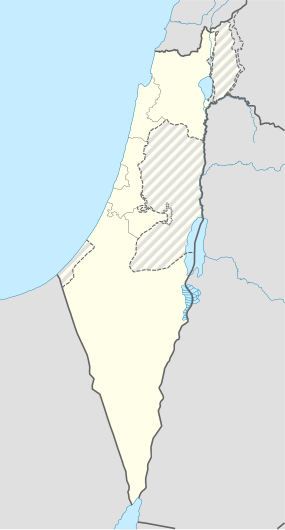Mosaic of Rehob
| ketovet reḥov | |

Mosaic of Rehob (click to enlarge)
|
|
| Alternate name | Inscription of Tel Rehov |
|---|---|
| Location | Tel el-Farwana (Khirbet Farwana), Israel |
| Region | Beit She'an, Israel |
| Coordinates | 32°27′47″N 35°29′37″E / 32.46306°N 35.49361°ECoordinates: 32°27′47″N 35°29′37″E / 32.46306°N 35.49361°E |
| Type | Mosaic |
| Part of | Synagogue |
| Area | 4.30 metres (14.1 ft) x 2.75 metres (9.0 ft) |
| History | |
| Founded | ca. 3rd century CE |
| Abandoned | 7th century CE |
| Periods | Roman to Byzantine |
| Cultures | Late Byzantium |
| Site notes | |
| Excavation dates | 1973 |
| Archaeologists | Yaakov Sussmann, Shaul Lieberman, Fanny Vito |
| Condition | Good (although removed from locale) |
| Ownership | Israel Museum |
| Public access | Yes |
| Website | www |
The Mosaic of Reḥob (also known as the Tel Rehov inscription) is a mosaic discovered in 1973, inlaid in the floor of the foyer or narthex of an ancient synagogue near Tel Rehov, 4.5 kilometers (2.8 mi) south of Beit She'an and about 6.5 kilometres (4.0 mi) west of the Jordan River, containing the longest written text hitherto discovered in any mosaic in the Land of Israel, as also the oldest known Talmudic text.
Unlike other mosaics found in the region, the Reḥob mosaic has very little in the form of ornate design and symmetric patterns, but is unique due to its inscription, acclaimed by scholars to be one of the most important epigraphical findings discovered in Israel in the last century. Its text sheds invaluable light on the historical geography (toponymy) of Palestine during the Roman and late-Byzantine periods, as well as on Jewish and non-Jewish ethnographic divisions in Palestine for the same periods and their relation to one another, specifically, on agricultural produce cultivated by farmers, and the extent of Jewish law regulating the use of such farm products grown in the region of Beit Shean (Scythopolis) and the Jordan valley, Sussitha (Hippos) and its neighboring cities on the east bank of the Sea of Galilee, Naveh (Nawā) in the Roman province of Arabia Petraea, Tyre and its neighboring cities to the south, as well as towns in the vicinity of Sebaste and Caesarea, and Ashqelon to the south. By delineating the boundaries of the Land of Israel, it seeks to establish the legal status of the country in its various parts from the time of Israel's return from the Babylonian captivity, and whether or not local farm products acquired by Jews from other Jews, or from gentiles and Samaritans, are exempt or obligated in what concerns the laws of Seventh Year produce, and of demai-produce. The mosaic also describes different kinds of fruits and vegetables that were cultivated in the country at the time.
...
Wikipedia

